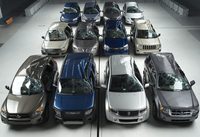First Rollover Tests of Midsize SUVs
First rollover tests of midsize SUVs: 5 of 12 models earn marginal ratings
ARLINGTON, VA — New test results show that some automakers are doing a good job of designing vehicle roofs that perform much better than current federal rollover standards require. The roofs on other vehicles need improvement. In the first Insurance Institute for Highway Safety roof strength tests of midsize SUVs, 6 earn the top rating of good for rollover protection, 1 is acceptable, and 5 others earn the second lowest rating of marginal.
Midsize SUVs earning good ratings are the 2010 Chevrolet Equinox (twin GMC Terrain) built after March 2010, Jeep Liberty (twin Dodge Nitro), Toyota Highlander and Venza, plus the Jeep Grand Cherokee and Kia Sorento, both 2011 models. The 2010 Ford Edge is rated acceptable. The worst performers, which earn marginal ratings, are the Honda Accord Crosstour, Honda Pilot, Mazda CX-7, Mitsubishi Endeavor, and Nissan Murano, all 2010 models.
In addition to earning good ratings for rollover protection, the Equinox, Grand Cherokee, Highlander, Sorento, and Venza also earn the Institute's Top Safety Pick award. To achieve this, a vehicle has to earn good ratings for occupant protection in front, side, rear, and rollover crashes. It also has to have electronic stability control.
The rollover rating system is based on Institute research showing that occupants in vehicles that roll benefit from stronger roofs. Vehicles rated good must have roofs that are more than twice as strong as the minimum required under the current federal safety standard. The ratings, products of the Institute's roof strength testing program, add to consumer information tests that rate vehicles' front, side, and rear crashworthiness. The rollover test is designed to help consumers pick vehicles that will protect them the best in one of the most serious kinds of crashes.
"Midsize SUVs are a big group so we're testing them in stages," says Institute president Adrian Lund. "First results show that automakers are making progress in rollover protection, but it's disappointing that a new design like the Crosstour didn't perform better."
Top performance in the roof test is important because nearly 10,000 people a year are killed in rollover crashes. When vehicles roll, their roofs hit the ground, deform, and crush. Stronger roofs crush less, reducing injury risk from contact with the roof itself. Stronger roofs also can prevent people, especially those who aren't using safety belts, from being ejected through windows, windshields, or doors that have broken or opened because the roof deformed. Roofs that don't collapse help keep people inside vehicles when they roll.
The best occupant protection is to keep vehicles from rolling in the first place. Electronic stability control is significantly reducing rollovers, especially fatal single-vehicle ones. When vehicles roll, side curtain airbags help protect people. Safety belt use is essential.
In the Institute's roof strength test, a metal plate is pushed against 1 corner of a roof at a constant speed. To earn a good rating, a roof must withstand a force of 4 times the vehicle's weight before reaching 5 inches of crush. For an acceptable rating, the minimum strength-to-weight ratio that's required is 3.25. A marginal rating value is 2.5, and anything lower than that is poor. The Grand Cherokee, Highlander, Liberty, and Venza, for example, withstood forces of nearly 5 times their weights. This compares with 2.8 times weight for the Crosstour and about 3 times weight for the Endeavor and Pilot. A strength-to-weight ratio of 4 reflects an estimated 50 percent reduction in serious or fatal injury risk in single-vehicle rollover crashes, compared with the current federal standard of 1.5.



